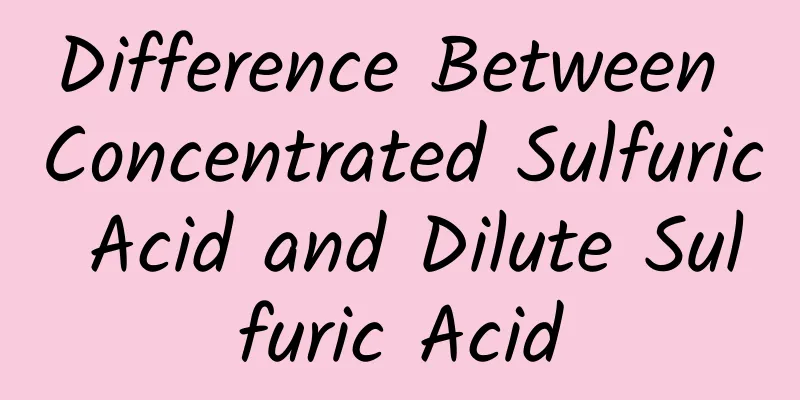Difference Between Concentrated Sulfuric Acid and Dilute Sulfuric Acid

|
Concentrated sulfuric acid and dilute sulfuric acid are both relatively common sulfuric acids. The biggest difference between them is of course the concentration. In daily life, if you want to distinguish concentrated sulfuric acid from dilute sulfuric acid, the main methods are physical and chemical methods. The most obvious physical method is weighing, because the concentration of concentrated sulfuric acid and dilute sulfuric acid is very different, the same volume is concentrated sulfuric acid. There are also viscosity method, boiling point method, etc. Difference Between Concentrated Sulfuric Acid and Dilute Sulfuric Acid Physical methods 1. Weighing method: Concentrated sulfuric acid has a greater density than dilute sulfuric acid (the density of 98% concentrated sulfuric acid is 1.84 g/mL). For the same volume, concentrated sulfuric acid is heavier. 2. Viscosity method: Concentrated sulfuric acid is a viscous liquid, while dilute sulfuric acid is close to the viscosity of water, so pick up the reagent bottle and shake it a few times. 3. Boiling point method: Sulfuric acid is a high boiling point acid. The boiling point of 98% concentrated sulfuric acid is 338°C. Therefore, a small amount can be heated in a test tube. The first one to boil and produce a large amount of water vapor is dilute sulfuric acid. 4. Dilution method: concentrated sulfuric acid releases a lot of heat when dissolved in water, so add 20mL of water in a small beaker, slowly add acid along the wall of the beaker (do not add water to the acid), and stir continuously with a glass rod. The concentrated sulfuric acid releases a lot of heat when dissolved. 5. Exposure method: Concentrated sulfuric acid is hygroscopic. After being exposed for a period of time, the concentrated sulfuric acid increases in mass. 6. Conductivity method: Take two carbon rods as electrodes, insert them into the acid, connect a small light bulb in series in the circuit, and use two dry batteries to form a closed loop. The small light bulb glows brightly when it is dilute sulfuric acid, because there is less water in concentrated sulfuric acid, most of the sulfuric acid molecules are not ionized, so there are few freely moving ions and the conductivity is poor. Chemical methods 1. Iron-aluminum method: Take a small amount of each into a test tube, add iron wire or aluminum sheet. If there is no phenomenon, it is concentrated sulfuric acid; if there are bubbles, it is dilute sulfuric acid. Because concentrated sulfuric acid can quickly oxidize the surface of metals such as iron and aluminum at room temperature to form a dense oxide film, causing "passivation". 2. Copper-carbon-sulfur method: Take two test tubes separately, add copper sheets or charcoal, then add acids respectively, and then heat. Concentrated sulfuric acid can produce irritating gas. 3. Gallstone method: Take two test tubes separately, add a little gallstone, and then add acid respectively. If the crystal dissolving solution turns blue, it is dilute sulfuric acid, and if the crystal surface turns white, it is concentrated sulfuric acid. 4. Cellulose method: Use a glass rod dipped in two acids to draw marks on paper, wood or cotton cloth. The concentrated sulfuric acid is used to dehydrate and carbonize the surface. 5. Sucrose method: Add about 10g of sucrose into a small beaker, drop in 1mL of water, and then add acid. The concentrated sulfuric acid can dehydrate and carbonize the sucrose to produce "black bread". 6. Salt (sodium nitrate) method: Add a little salt into the test tube, and then add acids respectively. Concentrated sulfuric acid produces irritating gas, while dilute sulfuric acid produces no irritating gas when salt dissolves. 7. Magnesium-zinc method: Dilute sulfuric acid reacts with magnesium and zinc to produce colorless and odorless hydrogen, while concentrated sulfuric acid reacts with magnesium and zinc to produce colorless sulfur dioxide with a pungent odor. 8. Test paper method: Drop on purple litmus paper, dilute sulfuric acid turns red, concentrated sulfuric acid carbonizes and turns black. No matter what substances you are identifying, you only need to find out the differences in their physical and chemical properties. |
<<: What is sulfuric acid paper?
>>: What is sulfuric acid used for?
Recommend
Effects and functions of Chinese medicine Pinellia
Pinellia is a traditional Chinese medicine. We us...
How to treat cerebral thrombosis. Traditional Chinese medicine prescriptions have good curative effects
Cerebral thrombosis is a common cardiovascular an...
What are the contraindications of taking Chinese herbal tonic medicine?
There are some taboos that we must pay attention ...
There is a life-saving button in this part of the body
Are you at a loss when it comes to sudden illness...
What to do in case of accidental miscarriage
You must take good care of your body after pregna...
What are the symptoms of qi deficiency and sinking in women?
The typical manifestations of Qi deficiency are w...
Facial seborrheic dermatitis treatment
The skin is the largest organ in our human body. ...
What medicine should be sprayed in the mouth for hand, foot and mouth disease?
It is almost the peak season for baby hand, foot ...
What to do if you have a sore throat due to a cold? Diet therapy can help you
Sore throat due to cold is very common, especiall...
What Chinese medicine should I take for insufficient stomach qi?
Insufficient stomach qi falls into the category o...
How to treat lumbar disc bulging
As people age, they experience different symptoms...
What are the treatments for infertility?
When it comes to the issue of infertility, many f...
What is papule herpes? What are the symptoms of herpes papulosa? How to treat it?
Herpes papulosa is a common sexually transmitted ...
Headache after washing
If you have a headache after washing your hair, y...
How to prepare Polygonatum sibiricum
Polygonatum odoratum can treat many diseases. It ...









